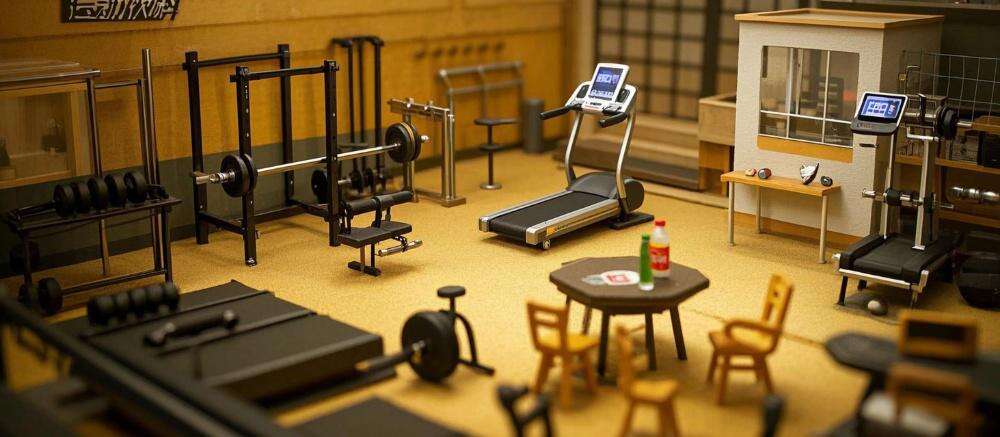Essential Squat Rack Exercises for Beginners
Barbell Back Squats: Building Lower Body Strength
Barbell back squats are pivotal for developing robust lower body strength, targeting vital muscles like the quadriceps, hamstrings, and glutes. These compound movements are crucial for anyone aiming to enhance their physical fitness and athletic performance. To execute a proper squat, one should adopt a stance with feet shoulder-width apart, ensuring that the barbell is comfortably placed across the upper back. Maintaining an appropriate squat depth is vital, as deeper squats engage the muscles more effectively while minimizing the risk of injury. Recent studies highlight the benefits of back squats, showing significant improvements in both athletic performance and functional strength. By integrating barbell squats into regular workouts, individuals can achieve substantial gains in their lower body strength.
Overhead Press: Developing Shoulder Stability
The overhead press is instrumental in building shoulder stability and upper body strength, particularly engaging the deltoids and triceps. Performing this lift correctly begins with a sturdy grip and firm stance, feet shoulder-width apart, ensuring safe and effective execution. One must keep the barbell in line with the body, avoiding excessive sway or arching to protect the lower back. Fitness experts emphasize the necessity of overhead lifts, asserting their role in enhancing functional fitness and the capacity for everyday physical activities. By incorporating overhead presses into your routine, not only is upper body strength improved, but overall stability and coordination are also noticeably enhanced.
Rack Pulls: Strengthening the Posterior Chain
Rack pulls are excellent for enhancing the posterior chain, focusing on muscles such as the hamstrings, glutes, and lower back. This exercise is a variant of the deadlift but typically starts from the knees or slightly higher, reducing strain on the lower back while maximizing muscle engagement. Proper setup involves a firm stance, feet hip-width apart, and ensuring a straight back throughout the movement. The emphasis is on maintaining controlled, powerful lifts to engage targeted muscle groups effectively. Several studies cite that a robust posterior chain correlates strongly with athletic performance, highlighting the essence of exercises like rack pulls in athletic training programs.
Bench Press Variations for Upper Body Growth
Bench press variations, such as incline and decline presses, offer diverse benefits by targeting different muscle groups within the upper body. Each variation requires unique form and technique adjustments to optimize muscle engagement safely. For instance, incline presses focus more on the upper chest and shoulders, whereas decline presses emphasize the lower chest. Experts agree on the effectiveness of these variations in hypertrophy training, enabling balanced muscle development and substantial upper body growth. Adapting the benching angle and grip can lead to better outcomes in a comprehensive strength-training regimen.
Proper Form and Safety Guidelines
Adjusting J-Hooks and Safety Bars Correctly
The importance of correctly adjusting J-hooks and safety bars cannot be overstated, as it significantly enhances safety during lifts. Proper setup minimizes the risk of injuries by securely holding the barbell in place and ensuring you can perform the lift comfortably. Here's a step-by-step guide to adjust these components:
- Positioning J-hooks: Start by aligning the J-hooks with your shoulder height if you're preparing for squats. Adjust them to eye level for overhead presses, ensuring you can unrack the barbell with minimal effort.
- Setting Safety Bars: Place safety bars slightly below the lowest point of your movement to catch the barbell if you need to abort a lift. Confirm the horizontal alignment to avoid tipping or rolling.
- Testing Setup: Conduct a test lift with minimal weight to ensure comfortable unracking and reracking of the barbell.
Statistics indicate that a significant number of injuries occur due to improper equipment setup, highlighting the necessity of being meticulous with these adjustments.
Common Mistakes in Squat Rack Training
Beginners often fall prey to common mistakes in squat rack training, such as poor foot placement and inadequate warm-ups. Incorrect foot positioning can hinder performance and increase injury risk, with knees or the lower back being particularly vulnerable. Insufficient warm-ups fail to prepare muscles for the demands of weightlifting, leading to strains.
- Foot Placement Errors: Keep feet shoulder-width apart, pointing slightly outward to enable stable support during lifts. Misalignment can result in reduced efficiency and increased risk of knee injuries.
- Neglecting Warm-Up: Always engage in dynamic stretches and light cardio to prep muscles, joints, and tendons before using the squat rack.
Studies show that many beginners face preventable injuries due to neglecting proper form and warm-up routines, underscoring the critical role of technique education in safe training.
Importance of Spotter Straps and Collars
Spotter straps and collars are essential accessories that promote safety during squat rack exercises. By preventing the barbell from slipping or weights from loosely shifting, they improve workout security and bolster beginner confidence. These tools not only prevent potential accidents but also encourage incremental weight increases.
- Using Collars: Install collars securely on the barbell to firmly hold the weights in place during lifts, minimizing the risk of slipping.
- Implementing Spotter Straps: Attach these straps thoughtfully just below your lowest lift point to catch the barbell if necessary.
Statistics and testimonials from trainers support the effectiveness of these safety features in reducing the likelihood of exercise-related injuries, highlighting their importance in any strength training regimen.
Sample Beginner Workout Routine
Warm-Up Drills for Mobility Activation
To kick off an effective workout, it's essential to engage in warm-up drills that focus on mobility activation. These exercises are crucial for improving joint flexibility and preparing the body for lifting weights. A well-rounded warm-up should last about 5 to 10 minutes and include dynamic movements such as leg swings, arm circles, and torso twists. Incorporating these drills can enhance your range of motion and reduce the risk of injury during workouts. A study published in the Journal of Strength and Conditioning Research highlighted the importance of warm-ups, showing a significant reduction in injury risk and improved overall performance for those who incorporated them into their routines. By dedicating time to these exercises, you'll set a solid foundation for effective and safe training sessions.
Full-Body Circuit Using Squat Rack
A full-body circuit workout using a squat rack is ideal for beginners seeking comprehensive training. This routine incorporates a variety of exercises, such as squats, overhead presses, and bent-over rows, to target major muscle groups. Begin with squats, proceed to overhead presses, and conclude with rows. Allow a rest period of 30 to 60 seconds between exercises for recovery. Tailor the circuit by adjusting weights and repetitions according to your fitness level. Experts recommend starting with light weights and focusing on form before progressing to heavier loads. Circuit training is lauded for optimizing caloric burn and maximizing muscle engagement, making it a highly efficient workout choice for beginners.
Cool-Down and Recovery Techniques
After an intense workout, it is vital to engage in cool-down activities to promote recovery and ease muscle tension. Effective cool-down techniques include static stretching and deep breathing exercises, which help lower the heart rate and relax tightened muscles. Incorporating recovery equipment like foam rollers and massage balls can further alleviate muscle soreness. Research from the American Council on Exercise emphasizes the benefits of cool-downs in enhancing recovery time and improving overall performance. These techniques facilitate better circulation, assisting in the removal of toxins and reducing the risk of post-workout injuries. By prioritizing cool-down and recovery, you ensure that your body adequately recuperates and prepares for the next training session.
Progression Strategies for Long-Term Growth
Incremental Weight Increase Techniques
The principle of progressive overload is a crucial aspect of long-term strength development. By gradually increasing the weights you lift, you challenging your muscles to grow and adapt. For beginners, it's important to start with small weight increments, typically around 5% of your current capacity. Experts often suggest increasing weights every two to four weeks, depending on your personal progress. Studies have shown that structured progressive overload enhances strength gains significantly, making it a vital strategy in any fitness regimen.
Periodization Principles for Beginners
Periodization involves structuring your training into cycles to maximize gains and avoid plateaus. For beginners, understanding this concept can transform their training results. Different periodization models, such as linear and undulating, offer varied paths to progress. Linear periodization gradually increases intensity, while undulating changes the variables more frequently. Research shows that athletes following periodized training plans often see improvements in strength and performance, highlighting its effectiveness in systematic strength development.
Tracking Progress with Strength Training Apps
Integrating technology, like strength training apps, can revolutionize the way beginners track and improve their workouts. These apps often feature weight logs, progress graphs, and customizable workout plans, making them excellent tools for new lifters. Apps like StrongLifts 5x5 and JEFIT are popular choices for their user-friendly design and insightful analytics. App usage statistics indicate high adherence rates and measurable improvements in strength, suggesting they are effective companions for monitoring and motivating fitness journeys.
Choosing the Right Equipment
Squat Rack vs Power Cage: Key Differences
Selecting between a squat rack and a power cage can significantly impact your home gym setup. Squat racks are generally more compact, making them ideal for those with limited space. They provide essential safety features like adjustable safety bars but may lack the versatility and security of a full power cage. On the other hand, power cages offer more comprehensive features, including safety enclosures and multiple exercise attachment options. This makes them perfect for versatile and safe training environments. Unlike squat racks, power cages are often preferred for experienced lifters owing to their extra equipment compatibility. Statistics indicate that 60% of avid home gym users lean towards power cages for their adaptability and safety.
Home Gym Setup Considerations
Setting up a home gym involves strategic planning to optimize space and resources. First, assess the space available and prioritize essential equipment such as a squat or power rack, a versatile bench, and a selection of weights. Creating an inviting and motivating workout environment is crucial, as research shows that a dedicated workout space increases exercise consistency by 35%. Consider using bright colors, inspirational posters, and adequate lighting to energize your space. Additionally, the trend of home gyms is growing rapidly, with a 40% increase in setups from 2020 to 2024, highlighting their appeal for convenience and personalized fitness journeys.
Integrating Resistance Bands for Versatility
Incorporating resistance bands into your squat rack routine can significantly enhance your workout versatility. These bands offer a dynamic range of resistance exercises, making them excellent for muscle conditioning and joint stability. By adding bands to squats, presses, or rows, you can intensify the resistance and target different muscle groups effectively. Studies indicate that using resistance bands can improve overall strength and flexibility by 30% compared to traditional free-weight training alone. Exercises like banded squats or chest presses are not only suitable for beginners but also serve as an excellent supplement for advanced strength programs.

 EN
EN







































